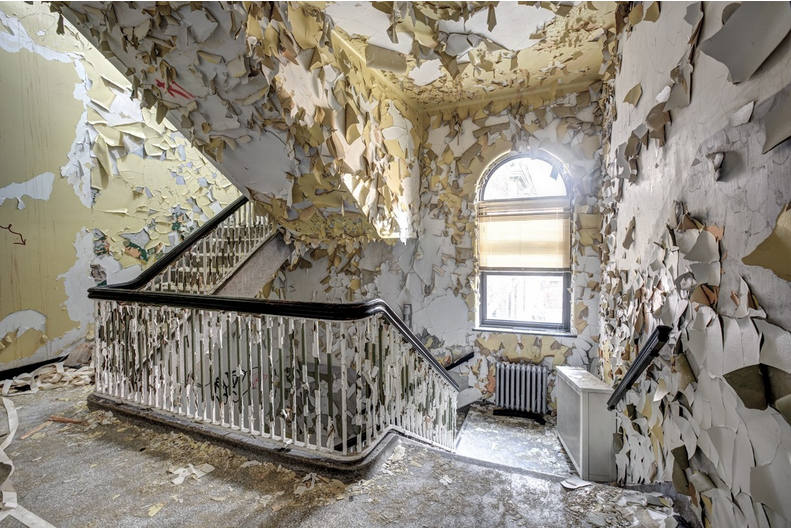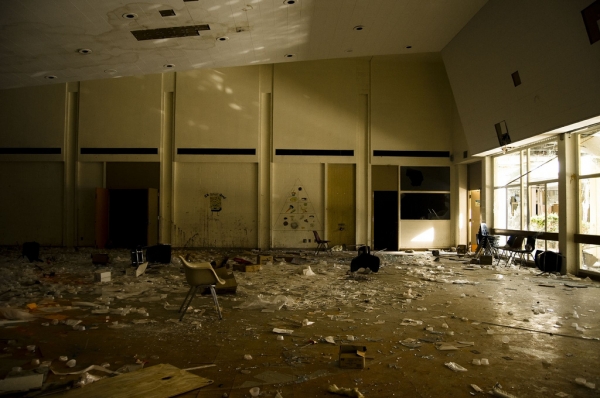by Shannon Polugar
Eric Holubow's "Shedding Stairwell" shot in 2008 at the Hyde Park Hospital in Illinois.
Abandoned places fascinate us and fill us with a variety of emotion: nostalgia for times gone by, a bit of fear, loneliness, awe. When photographs of these abandoned or destroyed places are done well, I think about this fascination in terms of a good amusement park. The nostalgia is the antique carousel. The tempered fear is the dark, haunted house. Loneliness is the ride you love but no one else will ride with you. Awe is taking the ferris wheel just to stop at the top to see the view.
However there is also a side of ruins porn photography that is darker. It is the old, seedy side-shows where some charismatic hustler is making a pitch in front of his booth, enticing the viewer into see some poor “different” person, and making a profit off their suffering.
The term “Ruins Porn” is credited to being first used by photographer James Griffioen, who used the term when he described how photographers would flock to the abandoned and derelict places in Detroit, not to show the story of the locations but to use the locations for their own entertainment, or to make a point about an unrelated topic. Of course he too photographed these places, but it was the intention that mattered to him.
Part of a short series by James Griffon, this is one of the images that helped to triple traffic to the Vice UK website
I however use the term more liberally. I don’t think it needs to be a term only used to describe those who some may find disrespectful to a place and its history, but as a term for the genre of taking photographs of abandoned places in general. Regardless of the photographer’s intent, the viewer still views the images because there is a quality to them that is fascinating. In his interview with Vice UK, their editor noted that Griffioen’s short series shot inside an abandoned Detroit school tripled the website’s traffic. So to the viewer, at least initially, it still deserves the ‘porn’ descriptor.
While Griffioen considered those using the long abandoned places for their own entertainment in terms of photography as bad apples, on the spectrum of ruins porn, I would argue they were the kids playing pranks: tasteless, but not inherently harmful.
There are far worse versions of ruins porn, and the debate is not a new one, though with the recent destructive forces of Hurricane Harvey in Texas and Hurricane Irma in the Caribbean and Florida, it is a topic ripe to be readdressed. Just as Griffioen complained about people flocking to his hometown in his interview with ArtNews in 2013, “with $40,000 cameras to take pictures of houses worth less than their hotel bills,” people also flock to natural disasters to do the same.
So what is the difference? It is the immediacy of human suffering. While in Griffioen’s Detroit the community has long suffered, the places photographers are flocking to for their fix of ruins porn are long detached from the individual. The abandoned Packard plant hasn’t been anyone’s place of work since the 1950s. The abandoned schools he muddles through haven’t seen a student since the late 1980s.
But the hurricanes and other natural disasters bring fresh destruction. Deaths are still being mourned. People are far from ‘moving on.’ In these cases if a photographer chooses to go, one has to be far more careful in their subject matter and intent. Their goal should be documentation, telling the story of the disaster and situation for what it is rather than entertainment value.
Victims of Hurricane Irma pick up the remains of their family business, but did they have any choice in their lives being photographed for the view of others?
Just this morning I came across the photograph above, and the attached article. At least the article helps get across the story of the people in the image, but one also can’t help but feel uncomfortable by it either. The reporter likely asked permission in this situation to photograph them as they pick of the pieces of their lives, but there it is also a hard situation to back out of. People want to be polite and helpful, and saying ‘yes’ could be easier than the perceived stress of someone asking again if you say no.
Some may argue that to documentary value wins out here, but I think if one asks themselves if they would want to be photographed in the same situation. The answer may change. Imagine the same scenario Griffioen described with the $40,000 cameras and outrageous hotel bills, and those people coming to photograph the mere fact that you just lost everything. You are suffering, without a home, without a business. They get to go back to their lives and livelihood. Where do you come out ahead by being their muse? Now imagine even worse that they aren’t a reporter for a non-profit news organization as with the photo above, but are profiting directly from your suffering? Not so nice.
This isn’t to say ruin porn in relation to disaster photography doesn’t have a necessary role, but the photographer should not be there because it is ‘cool’. It should be in service to the community in suffering.
Image 12 in the Silent Existence series, taken of the aftermath of the 2011 Japanese Earthquake and Tsunami, in city of Ishinomaki. Hyakutake presents the images as a ‘new page in Japanese postwar history’.
Tetsugo Hyakutake’s series “Silent Existence”, taken of the aftermath of the 2011 Japanese Earthquake and Tsunami is a good example of how one can document in the realm of ruins porn without taking advantage of the people who are suffering. He took the images with no one else around, the people had left. Their suffering while recent was not immediately present in the images.
Back to James Griffioen. He doesn’t go traveling across the country to the latest and greatest site that has been ‘found’ to photograph the abandoned remnants of society. He stays in his own area, a place where he is personally invested, and a place where he feels that his voice as a photographer can add to our understanding of the predicaments his city has faced.
His approach should be the goal of ruins photography: adding meaning to the places that remain even as we seek out the photographs because of our own personal attraction to the emotions they bring forth.
http://ebow.org/section/76239-Hyde-Park-Hospital.html
https://www.vice.com/en_us/article/ppzb9z/something-something-something-detroit-994-v16n8
http://www.jamesgriffioen.net/index.php?/photography/vacant-schools/
http://www.artnews.com/2013/02/06/the-debate-over-ruin-porn/




